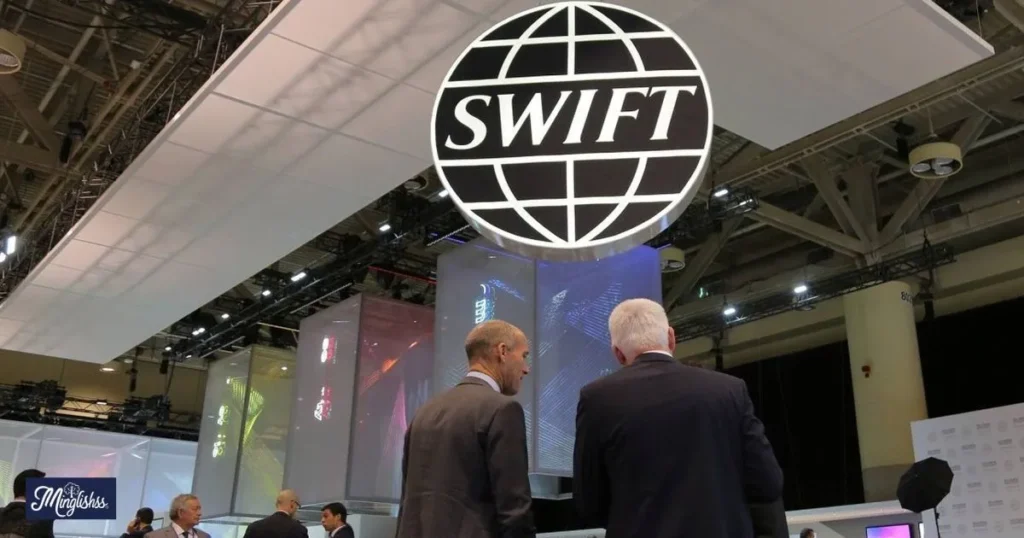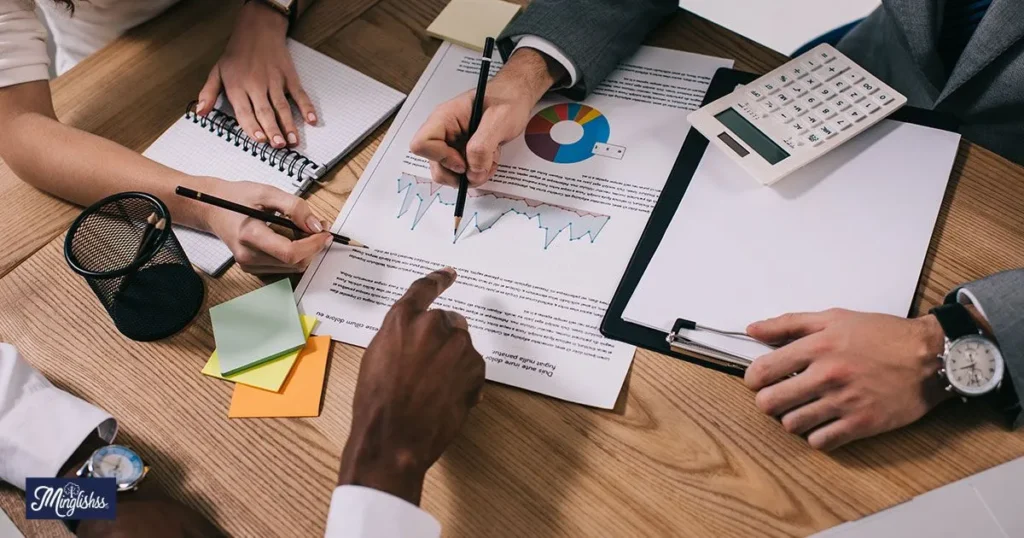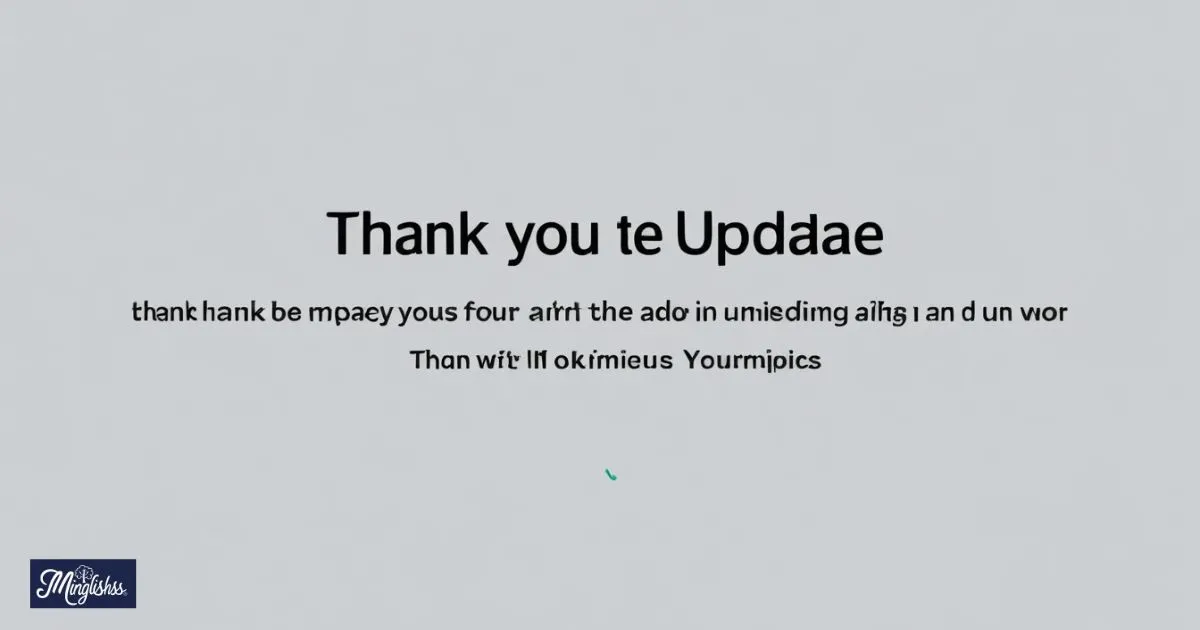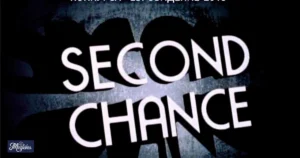“Thanking someone for an update can open doors to meaningful conversations and better relationships in both work and personal settings.”
In today’s fast-paced world, staying informed is crucial. Whether in professional or personal scenarios, updates provide us with the latest information to keep moving forward, stay aligned with goals, or even adjust strategies. Expressing gratitude for updates is a great way to strengthen communication and foster a collaborative environment. However, simply saying “Thank you for the update” might not always convey the level of appreciation or understanding you’d like to share.
Imagine standing out with thoughtful, varied expressions of gratitude. Showing that you truly value an update can set you apart as attentive and considerate, which can foster trust and strengthen connections. That’s why finding unique and personalized ways to express thanks is key. Whether you’re speaking to a colleague, manager, or friend, adjusting your approach to fit the situation can make your acknowledgment feel more genuine and impactful.
Ready to elevate your communication style? Here, we’ll dive into 35 unique ways to say “Thank you for the update” with real-life scenarios, explanation tips, and practical insights for each one. These alternatives will help you sound professional, friendly, and responsive. Let’s start building stronger connections by rethinking how we express gratitude!
1. “I really appreciate the timely update.”
Scenario: Emma just received an email update about a project’s progress from her teammate.
Explanation: This phrase acknowledges that the update was delivered in good time, emphasizing its importance to the recipient.
Additional Tip: Use this phrase when you want to convey the importance of time-sensitive information.
2. “Thanks for keeping me in the loop!”
Scenario: James received a brief update on a policy change that might impact his department.
Explanation: This friendly expression lets the sender know you appreciate being informed, especially in evolving situations.
Additional Tip: Great for casual workplace environments or updates that may be ongoing.
3. “I’m grateful for the heads-up.”

Scenario: Laura was alerted to an upcoming schedule shift by her supervisor.
Explanation: This phrase conveys appreciation for proactive communication, showing that you value being prepared.
Additional Tip: Ideal when the update allows you to prepare or adjust plans accordingly.
4. “Thank you for taking the time to fill me in.”
Scenario: After a team meeting, Mark’s colleague emails a summary of the main points discussed.
Explanation: This expression appreciates the effort taken to provide a thorough update.
Additional Tip: Use this when the update is detailed and shows genuine consideration.
5. “Much appreciated! I’ll adjust accordingly.”
Scenario: Sarah’s manager notifies her about a change in the project’s deadline.
Explanation: This acknowledges the update and signals your readiness to adapt.
Additional Tip: Useful when there’s a direct action or adjustment needed on your part.
6. “Thanks for sharing this information!”
Scenario: Daniel receives data from his colleague to complete his report.
Explanation: This phrase is simple yet effective for general informational updates.
Additional Tip: Works well in situations where you’re collaborating on a task.
7. “I value the update and the effort behind it.”

Scenario: Rachel gets a comprehensive email summary after a complex meeting.
Explanation: This expresses gratitude not just for the information but also for the effort involved.
Additional Tip: Shows respect for someone’s time and attention to detail.
8. “Your update is really helpful—thanks!”
Scenario: Emily’s team lead shares the project’s progress and next steps.
Explanation: Here, you’re acknowledging how the update specifically helps you.
Additional Tip: Adds a positive tone when the update directly benefits your tasks.
9. “Thank you for the clarification.”
Scenario: John receives detailed information that clears up some initial confusion.
Explanation: This phrase is perfect when the update provides much-needed clarity.
Additional Tip: Use this when the information resolves prior uncertainties.
10. “This update means a lot—thanks!”
Scenario: Hannah is working closely with her team, and her colleague shares timely insights.
Explanation: This adds a touch of warmth, showing personal appreciation for the update.
Additional Tip: A great way to build rapport in close working relationships.
11. “I appreciate the clarity you’ve provided with this update.”
Scenario: You’ve just received a report from a project manager detailing the next steps for a project, which clarifies any potential confusion.
Explanation: When someone’s update provides clear, organized information, recognizing their effort can enhance trust and encourage them to keep you in the loop. By emphasizing “clarity,” you acknowledge the extra thought they put into making the information digestible.
Additional Tip: Use this phrasing whenever the update includes diagrams, examples, or simplified explanations that improve comprehension.
12. “Thanks for keeping me informed—I feel confident about our next steps.”

Scenario: After a team meeting, a colleague sends a follow-up email summarizing the discussed action items.
Explanation: Showing appreciation for updates that instill confidence demonstrates that the sender’s information helped you feel prepared. This response subtly reinforces that their summary was both useful and motivating.
Additional Insight: This is a great way to show appreciation to team members who regularly contribute to maintaining organization and clarity.
13. “Your attention to detail in this update is impressive—thanks for sharing!”
Scenario: You receive an update that includes intricate details on project requirements, preventing potential errors down the road.
Explanation: Recognizing attention to detail highlights that you value thoroughness, which can encourage continued diligence. This shows you’re not only grateful for the information but also for the time invested in preparing it.
Additional Tip: Use this for complex projects or discussions involving detailed figures, timelines, or specific instructions.
14. “Thank you for looping me in; it helps me see the bigger picture.”
Scenario: You’re informed about a new initiative in the company that aligns with ongoing work.
Explanation: Expressing that the update gives you perspective implies that staying informed enhances your understanding of broader goals. This reinforces your commitment to the team’s success.
Additional Insight: Perfect for times when cross-department updates provide insight into organizational changes or shared goals.
15. “Much appreciated—I’ll be sure to act on this right away.”
Scenario: You receive a task update from your manager that requires your immediate attention.
Explanation: Indicating that you’ll act on the information demonstrates accountability and ensures the sender that their update will not go unnoticed.
Additional Tip: This response works well for situations where updates include action items or deadlines that impact others’ work.
16. “Thanks for shedding light on this—it makes a big difference!”

Scenario: A colleague’s update clarifies a previously confusing issue, helping you understand the situation better.
Explanation: “Shedding light” implies that their update brought much-needed clarity, suggesting that their information resolved ambiguity. It’s a warm, grateful way to acknowledge valuable insights.
Additional Tip: Use this when an update resolves something you found challenging or puzzling.
17. “Your update has brought so much clarity—thank you for keeping me in the loop!”
Scenario: A teammate provides an update clarifying roles and responsibilities for a collaborative project.
Explanation: Emphasizing how the update provided “clarity” shows that the information was helpful in defining tasks or expectations. It encourages the sender to continue providing such thorough updates.
Additional Insight: Effective in team settings where roles and clarity are crucial for smooth collaboration.
18. “Thanks for the timely update—this really helps with my planning.”
Scenario: You receive an update early, giving you ample time to adjust your schedule or plans.
Explanation: By mentioning “timely,” you’re acknowledging that the update arrived exactly when needed, which can positively reinforce the sender’s proactive approach.
Additional Tip: Ideal when dealing with deadlines or any situation that benefits from advance notice.
19. “Thank you for the detailed breakdown—it’s exactly what I needed!”
Scenario: A colleague sends an update with a thorough breakdown of recent project developments.
Explanation: Expressing thanks for a “detailed breakdown” conveys appreciation for the thoroughness and organization that went into the update. This feedback encourages similar efforts in future communications.
Additional Insight: Use this when updates are particularly well-organized or helpful in answering questions.
20. “Thank you! Your update is really helping me stay on track.”

Scenario: You’ve been catching up on multiple tasks, and this update provides just what you need to stay focused.
Explanation: Acknowledging that the update helps you “stay on track” indicates that the sender’s information is critical to your progress. It’s also a subtle way of sharing that their communication helps you succeed.
Additional Tip: Great for team collaborations where mutual progress is essential.
21. “I’m grateful for the heads-up—it’s keeping everything running smoothly on my end.”
Scenario: A team member informs you of an upcoming change that may affect your work.
Explanation: Showing appreciation for a “heads-up” communicates that you value proactive communication, which can prevent misunderstandings or delays.
Additional Insight: This is perfect for situations involving project adjustments or operational changes.
22. “Thank you for the insightful update—it’s really thought-provoking!”
Scenario: You receive an update that offers not just information, but unique insights or viewpoints.
Explanation: Expressing gratitude for an “insightful” update shows that you’re not only informed but also inspired by the information. It’s a compliment that can encourage others to share perspectives in the future.
Additional Tip: Use this response when someone goes beyond basic updates to share perspectives.
Other Ways to Say Thank You for Your Payment
23. “Your update really brought me up to speed—thanks so much!”
Scenario: A colleague’s email covers recent changes you weren’t aware of, helping you quickly understand the current situation.
Explanation: “Brought me up to speed” suggests that the update filled in essential gaps, which reflects gratitude for the sender’s role in keeping you informed.
Additional Insight: Effective in dynamic environments where staying informed is essential.
24. “Thank you for addressing this so thoroughly—it’s a big help!”
Scenario: A teammate provides a comprehensive answer to an ongoing issue.
Explanation: Appreciating a thorough response reinforces their effort in providing complete information, which can help solve complex or ongoing challenges.
Additional Tip: Use this for updates involving detailed explanations of processes, problems, or solutions.
25. “Thanks for the swift update—it really helped me stay prepared!”

Scenario: You receive an update sooner than expected, allowing you to prepare adequately.
Explanation: “Swift update” signals that you value timely information, especially when it aids your readiness or response.
Additional Insight: Perfect for fast-paced environments where quick updates are essential for preparation.
26. “Thanks for getting this on my radar—I appreciate the reminder.”
Scenario: A colleague sends a gentle nudge about an upcoming deadline that you might have overlooked.
Explanation: Acknowledging that the update helped “get it on your radar” shows appreciation for the proactive reminder. It reinforces that you value your colleague’s support in staying on top of tasks.
Additional Insight: This response is particularly useful for deadline-oriented projects or time-sensitive tasks.
27. “Your update is just what I needed to get started—thank you!”
Scenario: You receive an update that provides the exact information needed to kick off a new project.
Explanation: Expressing that the update is “just what you needed” reinforces that it was both helpful and timely, encouraging the sender to continue providing relevant information in the future.
Additional Tip: Use this phrase when an update answers preliminary questions or offers clear directions.
28. “I’m grateful for this update—it really sets the stage for my next steps.”
Scenario: A manager sends an update that provides critical details, allowing you to plan and organize your next actions effectively.
Explanation: Highlighting that the update “sets the stage” demonstrates how the information helps you strategize, showing respect for the sender’s role in keeping you prepared.
Additional Insight: This response works well for large projects where ongoing clarity is essential.
29. “Thank you for bringing this to my attention—I hadn’t considered this angle.”
Scenario: A colleague shares new insights on a project, introducing a perspective you hadn’t thought of.
Explanation: By recognizing the “new angle,” you’re showing appreciation for their unique contribution, which can encourage innovative thinking and open dialogue.
Additional Tip: Ideal when someone’s update brings fresh insights that could shape decisions or enhance strategies.
30. “Thank you for the proactive update—this helps avoid potential issues down the line.”

Scenario: You’re informed of a procedural change early enough to make necessary adjustments without delays.
Explanation: Acknowledging the “proactive” nature of the update reflects that the early notice is useful and valued, reinforcing the importance of timely communication.
Additional Insight: Use this for updates that involve process changes or preventive measures, especially when they help minimize future challenges.
31. “Thanks for filling me in on the background—it adds a lot of context.”
Scenario: A teammate provides extra background details on a project, helping you understand the bigger picture.
Explanation: Recognizing the added context shows you value the comprehensive insight, which can strengthen teamwork by fostering shared understanding.
Additional Tip: This is effective for complex projects or when collaborating with new team members.
32. “I’m glad you shared this—it’s helping me reprioritize accordingly.”
Scenario: An update reveals changes in project priorities, allowing you to reorganize your tasks.
Explanation: Noting that the update helps you “reprioritize” shows that you’re ready to adapt and stay aligned with project goals, reinforcing that you value teamwork.
Additional Insight: Use this when updates reveal changes in task urgency or project timelines.
33. “Thank you for the heads-up—this helps me prepare for what’s coming next.”
Scenario: A supervisor shares upcoming changes in company policy that might impact your work.
Explanation: Appreciating a “heads-up” conveys that you value advance notice, helping you better manage your responsibilities. This can build a positive, proactive culture within your team.
Additional Tip: Ideal for updates on policy changes, new guidelines, or shifts in project expectations.
34. “I appreciate your diligence in keeping me informed—thank you for the consistent updates.”

Scenario: A colleague regularly updates you on progress in a joint project, ensuring that everything stays on track.
Explanation: Recognizing their “diligence” shows that you don’t take their effort for granted, promoting a culture of continuous feedback and collaboration.
Additional Insight: Use this when a team member or supervisor goes out of their way to provide routine updates.
35. “Thanks for clearing this up—it’s exactly what I needed to move forward.”
Scenario: You ask for clarification on an unclear point, and a teammate provides an answer that removes any ambiguity.
Explanation: Expressing thanks for “clearing this up” demonstrates appreciation for their help in removing obstacles, which can motivate others to continue supporting your efforts.
Additional Tip: This response is useful for direct questions or when addressing minor misunderstandings.
Pros and Cons of Using Alternative Expressions to “Thank You for the Update”
Pros:
- Adds Variety to Communication: Using different phrases keeps your communication fresh and engaging, showing attentiveness and thoughtfulness.
- Builds Stronger Connections: Personalized expressions can make the recipient feel valued, fostering better professional and personal relationships.
- Shows Attention to Detail: Choosing a specific phrase tailored to the situation shows that you’ve put thought into your response, making it more meaningful.
- Encourages Open Communication: Thoughtful responses can motivate others to continue providing timely, clear updates, as they feel acknowledged.
- Prevents Miscommunication: Using specific language, like “thanks for the clarification” or “appreciate the heads-up,” makes your appreciation more transparent and reinforces understanding.
Cons:
- May Feel Overly Formal or Informal: Some expressions may not match the tone of every situation, and it can be tricky to gauge the right level of formality.
- Time-Consuming: Finding the right words to match each scenario takes time and effort, especially in fast-paced environments.
- Risk of Overuse: Using too many unique expressions repeatedly could seem forced or insincere if not used naturally.
- Potential for Misinterpretation: Some alternatives might be misunderstood, especially if the recipient is unfamiliar with the phrase or if it’s too indirect.
- Can Feel Inconsistent: Constantly changing expressions might confuse colleagues, as they may wonder if certain phrases imply different levels of urgency or importance.
Key Insight
1. Why should I use alternative phrases instead of simply saying “Thank you for the update”?
Using varied phrases shows that you’re paying attention to the context and specific value of each update. It keeps communication fresh and personalized, which can make colleagues feel more appreciated and encourage continued open communication.
2. What’s a good alternative if I receive an update with new information I hadn’t considered?
You could say, “Thank you for bringing this to my attention—I hadn’t considered this angle.” This response shows you’re open to new insights and value the unique perspective they provided.
3. How do I respond if an update helps me complete my work more efficiently?
A good option is, “Your update is just what I needed to get started—thank you!” This acknowledges that their information was timely and essential to your progress, which makes your appreciation more specific.
4. Are there alternatives that work well in more formal settings?
Yes, phrases like “Thank you for the clarification; it’s invaluable” or “I appreciate the detailed information—this is very helpful” maintain a formal tone while showing sincere gratitude.
5. How do I know which phrase to use in each situation?
Consider the context of the update and its impact on your work. If it was a reminder, choose a phrase that highlights timeliness. If it was new information, go for phrases that acknowledge the insight. Matching your response to the situation makes your gratitude more genuine and impactful.
Conclusion
Expressing gratitude for updates with thoughtful, unique phrases can greatly impact your communication. Rather than the standard “Thank you for the update,” using personalized messages shows that you value both the information and the person sharing it.
This approach builds rapport, encourages effective communication, and helps establish a positive, collaborative atmosphere. In both professional and personal contexts, these small expressions of gratitude go a long way in nurturing meaningful relationships and ensuring clear, engaging exchanges.
By using these 25 additional ways to say “Thank you for the update,” you’ll bring freshness and sincerity to your communication, making each interaction more memorable and appreciated. Remember, a simple adjustment in wording can help foster a workplace culture of mutual respect and acknowledgment.

Hi, I’m Ethan Matthews: I make English easy with my clear and simple teaching style. I love helping learners feel confident in every lesson.










